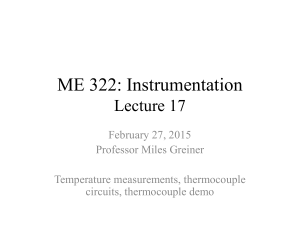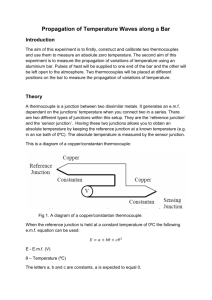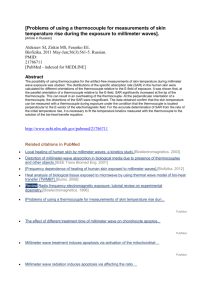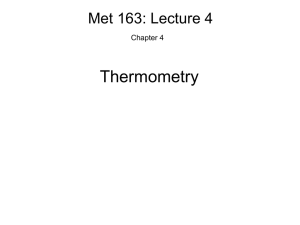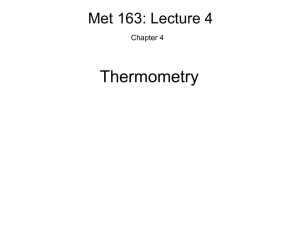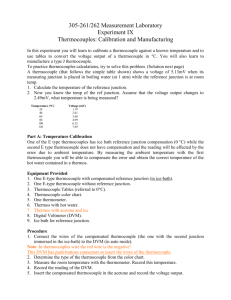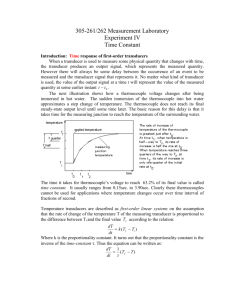WBS Introduction Thermocouple-ISE
advertisement
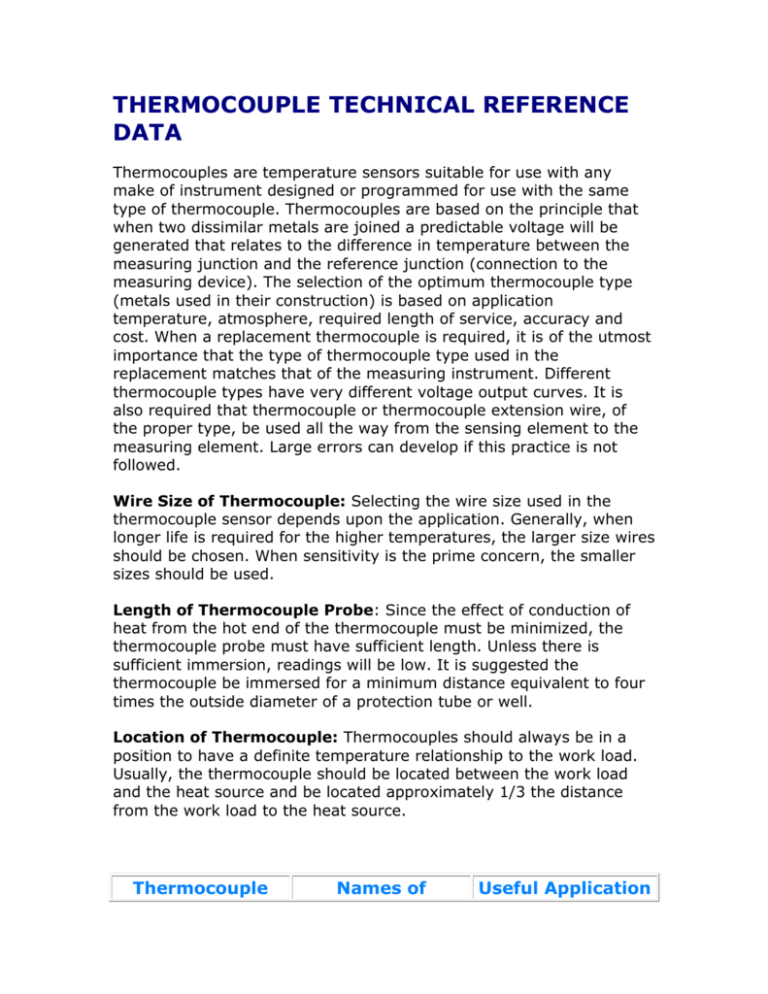
THERMOCOUPLE TECHNICAL REFERENCE DATA Thermocouples are temperature sensors suitable for use with any make of instrument designed or programmed for use with the same type of thermocouple. Thermocouples are based on the principle that when two dissimilar metals are joined a predictable voltage will be generated that relates to the difference in temperature between the measuring junction and the reference junction (connection to the measuring device). The selection of the optimum thermocouple type (metals used in their construction) is based on application temperature, atmosphere, required length of service, accuracy and cost. When a replacement thermocouple is required, it is of the utmost importance that the type of thermocouple type used in the replacement matches that of the measuring instrument. Different thermocouple types have very different voltage output curves. It is also required that thermocouple or thermocouple extension wire, of the proper type, be used all the way from the sensing element to the measuring element. Large errors can develop if this practice is not followed. Wire Size of Thermocouple: Selecting the wire size used in the thermocouple sensor depends upon the application. Generally, when longer life is required for the higher temperatures, the larger size wires should be chosen. When sensitivity is the prime concern, the smaller sizes should be used. Length of Thermocouple Probe: Since the effect of conduction of heat from the hot end of the thermocouple must be minimized, the thermocouple probe must have sufficient length. Unless there is sufficient immersion, readings will be low. It is suggested the thermocouple be immersed for a minimum distance equivalent to four times the outside diameter of a protection tube or well. Location of Thermocouple: Thermocouples should always be in a position to have a definite temperature relationship to the work load. Usually, the thermocouple should be located between the work load and the heat source and be located approximately 1/3 the distance from the work load to the heat source. Thermocouple Names of Useful Application Type Materials Range B Platinum30% Rhodium (+) 2500 -3100F Platinum 6% Rhodium (-) 1370-1700C W5Re Tungsten 5% Rhenium (+) 3000-4200F W26Re Tungsten 26% Rhenium (-) 1650-2315C Chromel (+) 200-1650F Constantan (-) 95-900C Iron (+) 200-1400F Constantan (-) 95-760C Chromel (+) 200-2300F Alumel (-) 95-1260C Nicrosil (+) 1200-2300F Nisil (-) 650-1260C Platinum 13% Rhodium (+) 1600-2640F C E J K N R S T Platinum (-) Platinum 10% Rhodium (+) Platinum (-) 870-1450C 1800-2640F 980-1450C Copper (+) -330-660F Constantan (-) -200-350C Thermocouple Reference Table (mV vs. Temperature) GLOSSARY OF TERMS Cold Junction or Reference Junction - The junction generally at the measuring device that is held at a relatively constant temperature. Cold Junction Compensation - Measures the ambient temperature at the connection of the thermocouple wire to the measuring device. This allows for accurate computation of the temperature at the hot junction by the measuring device. Dual Element - Two thermocouple elements housed within one thermocouple hardware assembly. Extension Wire - Wires which connect the thermocouple itself to a reference junction, i.e. controller, receiver, recorder, etc. Extension wire must be of the same type as the thermocouple. Special plugs and jacks made of the same alloys as the thermocouple should be used if a quick disconnect is required for the application. Grounded Junction - The internal conductors of this thermocouple are welded directly to the surrounding sheath material, forming a completely sealed integral junction. Ungrounded Junction - Although the internal thermocouple conductors are welded together they are electrically insulated from the external sheath material and are not connected to the sheath in any way. Ungrounded junction thermocouples are ideal for use in conductive solutions or wherever circuit isolation is required. Ungrounded junctions are required where the measuring instrumentation does not provide channel to channel isolation. Exposed Junction - The thermocouple junction or measuring point is exposed without any protection assembly or tube. Exposed junction thermocouples due to their design, offer the user the fastest response time. Hot Junction - The measuring junction. Immersion Length - The portion of the thermocouple which is subject to the temperature which is being measured. Measuring Junction - The junction in a thermocouple which actually measures the temperature of the object. Often referred to as the Hot Junction. Protection Tube - A tube like assembly in which the thermocouple is installed in order to protect the element from harsh environments. RTD - Abbreviation for Resistance Temperature Detector. It is a sensor which operates on the principle that the resistance increases with an increase in temperature at a specific rate. Commonly manufactured using a platinum resistance element. More accurate and more linear than most thermocouples and generally much more costly and slower responding. Thermocouple - A temperature sensor based on the principle that a voltage is produced when two dissimilar metals. The junction produces a voltage in proportion to the difference in temperature between the measuring junction and the reference junction. Thermowell - A threaded or flanged closed end tube which is mounted directly to the process or vessel, designed to protect the thermocouple from the process surroundings. Thermocouple Color Codes: Thermocouple wiring is color coded by thermocouple types. Different countries utilize different color coding. Jacket coloring is sometimes a colored stripe instead of a solid color as shown. United States ASTM: British BS1843: 1952: British BS4937: Part 30: 1993: French NFE: German DIN:
